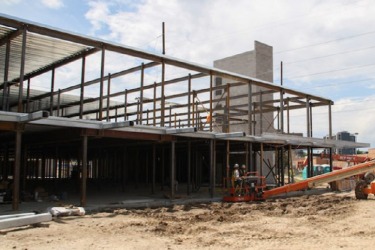Steel has long been a favored material for large construction projects since the inception of industrial-level manufacturing. Without it, skyscrapers couldn’t exist. Understand Building Construction explains the reason why. Steel, unlike masonry, wood and other construction support materials, has a terrific strength-to-weight ratio and flexes with force. The ductile feature of steel renders this super strong metal perfect for high rises subject to high winds and possible earthquakes. Plus, its stalwart nature enables building designs with much longer spans between vertical supports. Not only can architects design more open floor plans, the savings in quantity of needed material makes steel budget-friendly. Assembled properly, steel framed buildings rarely collapse.
Not only economical, building with steel is “green.” Using steel reduces demand for timber. Additionally, according to Steel Recycling Institute, all steel products contain recycled steel, and framing products usually contain a minimum of 25 percent. If constructing a stick-built 2,000-square-foot house, up to 50 trees, or about an acre of forest, would come down. But with steel, roughly six scrapped cars would render their bones to frame the home.
Depending on the desired application, steel framing can call for either light gauge or structural steel. Because Barton Supply provides both, here’s a comparison of the two types.
LIGHT GAUGE
WHAT IS IT?
This steel is cold formed, meaning long, thin sheets are guided through a series of rollers to bend and shape the sheets into strong “C” or “Z” forms capable of holding heavy loads. They can be sized to conform to wood studs of 2×4 or 2×6 inches and can be bent for architectural purposes, unlike timber. Light gauge supports will come galvanized with zinc, aluminum or a combination thereof. Like wood framing, a load-bearing wall is constructed first, then interior partitions and exterior cladding follow.
WHAT ARE THE ADVANTAGES OF LIGHT GAUGE STEEL FRAMING?
Light gauge steel can replace lumber in residential and light commercial structures. It serves perfectly for load-bearing walls and interior rooms. However, due to its strength, studs can be 24 inches on center rather than the customary 18 or 20 inches, reducing the number of studs necessary to frame a wall.
Framing is quite similar to wood, but very little cutting and sizing need occur at the job site as the studs are manufactured to precise lengths. Most experienced light gauge framers fasten the parts with self-tapping screws. Because of its light weight, each piece can be carried by hand. The longer spans means less fastening and faster construction. As a metal, light gauge steel won’t rot, split, warp, shrink twist, burn or become termite food.
Steel framing produces far less on-site waste than wood framing, making debris removal less costly. Also, since it goes to recycling facilities, the waste can even produce some income to offset project costs.
WHAT ARE THE DISADVANTAGES?
While light gauge steel won’t burn, it can lose strength in a fire. In buildings finished in, and furnished with, combustible materials, cladding must be with Class A fire rated materials. Also, steel’s conductive properties call for a different insulation design. To avoid drawing exterior cold into the building, it may be best to use high R value rigid insulation layers on the outside of the studs. Similar to its thermal conductivity, steel also transmits sounds more readily than wood. Internal soundproofing materials may need to be incorporated into the building’s design. Subject to rusting, water may be steel’s only nemesis.
STRUCTURAL STEEL
WHAT IS IT?
Structural steel is hot rolled while molten and hardened, making it incredibly strong. Understanding Building Construction illustrates the strength of structural steel by explaining that from a one-inch circular bar firmly attached to supports, one can suspend either two and a half African elephants, 18 Honda City Cars or one and a half London double-decker city buses. All of which, separately, weigh about 20 tons.
Used in conjunction with concrete, the most durable structures employ structural steel. Because it is thicker and much heavier than light gauge steel, the best fastening methods employ welding, bolting or riveting.
WHAT ARE THE ADVANTAGES OF STRUCTURAL STEEL?
Suitable for multi-story buildings, bridges and industrial plants, structural steel offers much longer spans and stout cantilevers. Its ductile properties allow it to flex without breaking during moderate seismic, events, heavy traffic loads and high winds. Concrete and quarried stone alone can’t compete with structural steel at great heights, hence its preference in skyscrapers where the weight of stone becomes untenable. If sufficiently reinforced with steel, concrete can support tall bridges or other components of modern infrastructure.
WHAT ARE THE DISADVANTAGES?
The weight of structural steel requires heavy trucks or trains (or maybe two and a half African elephants) for delivery and cranes for placement. For small-scale buildings like houses or light industrial plants, the weight adds considerable cost to the project. For homes, structural steel seems like overkill. For medium-sized commercial building, framing often uses both structural and light gauge steel.
Both structural and light gauge steel make for excellent framing materials in all manner of construction designs. Sturdy, difficult to destroy, impervious to pests and most elements, economical and recyclable, steel has few framing peers.
